Ocean City, New Jersey Lifetime Resident, Dewey Powell’s 4WD, 392 Hemi Powered Corvette to the Rescue!
When you live close to the shore, like I do, it’s not uncommon to see 4WD vehicles with surf fishing racks on the front bumper. The formula is this; fishing racks + beach = 4WD vehicle, usually a truck. That’s what threw me when I first saw Dewey Powell’s menacingly cool-looking ‘81-bodied Corvette at the Strictly Corvettes Show, in Atlantic City, New Jersey. The first thing I noticed was the stylized fishing pole rack and the way it was angled back from the middle to match the car’s pointed nose. Then the tall tires and L88 wheel flares got me. “WOW! What’s this?” When I looked under the hood and saw a dual-quad 392 Hemi, I said, “Who built this?!”
Dewey was completely relaxed in a lawn chair, wearing jeans, black cowboy boots, a black t-shirt, and his wrap-around shades. I could tell that he was “the guy.” I asked him, “I’ll bet that this is your car and you built it, right?” “Yea, that’s right, and I drove it here today. You should have seen it yesterday, it was covered with sand.” I had just met Ocean City’s local legend, Dewey Powell.
Dewey often starts his day with a drive on the beach. This ain’t no beauty queen, it’s a daily driver!
Dewey is what you call, “Old School.” You could also say that he truly has gasoline in his veins. As a small child, Dewey helped out at his Dad’s Esso gas station that opened in 1912. By 1945, Dewey was pumping gas and looking to fast at the local 1/8th-mile drag strip with his Model A Pickup truck powered by a Chevy engine. Dewey’s uncle owned one of the most famous dirt tracks in South Jersey. Over the decades the track was named Powell Speedway, then Pleasantville Speedway, and finally, Atlantic City Speedway. Today, the old race track is long gone but Dewey is still powering around in one of several of his hand-made machines. This was definitely a racing family and Dewey built all sorts of dirt track and drag cars. Dirt track racers are unique in that they don’t mind fixing cars that get slammed around. If something breaks, you fix it and get back on the track. They’re also very good at mixing and matching parts from all kinds of cars in order to reach their objective.
[nggallery id=1]
Dewey’s 4WD Corvette comes from that kind of “garage engineering.” The basic structure of Dewey’s car is a ‘69 Corvette. When he bought the car in ‘76, the former owner had the car setup for drag racing with a turbocharged LS6 454. Life can be hard for cars that reside along the shore, as the salt air eats them alive. The original body was completely shot, but it just happened that a friend had a body from an ‘81 Corvette for the right price. Being a career mechanic and having access to lots of parts, Dewey started another of his car projects.
With the car completely stripped and a new body waiting, Dewey set about building his 4WD Corvette. The C3 Corvette rides on a short, 98-inch wheelbase. Since the front-wheel drive unit was coming out of a Cadillac Eldorado and a transfer cast was to be mounted behind the transmission, Dewey needed an engine that is shorter than a big-block Chevy. Dewey had raced Hemis before and thought, “Why not!”
I believe that it’s physically IMPOSSIBLE to stuff more engine between the frame rails of a Corvette than this!
The 392 Hemi is out of a ‘58 Chrysler New Yorker. We tend to forget how much cast iron was in those old Hemis. With a Turbo 400 and an 1,800 RPM stall torque converter, Dewey’s engine, trans, and 4WD transfer case weighs around 1,000-pounds. The 392 Hemi has 10.5:1 compression and uses a .490-life hydraulic lifter with stainless steel valves. The aluminum intake manifold is the only substantial part on this engine that’s not cast-iron. The current two Edelbrock carbs will soon be replaced with two 600 Hollys.
Driving the front wheels is a very interesting collection of parts. The front-wheel drive unit is from a ‘70s Cadillac Eldorado and includes the frame, front suspension, spindles, brakes, and steering box. Each front axle was custom made. The Jeep transfer case is mounted behind the transmission with a one-piece drive shaft running to the rear and a two-piece drive-shaft running to the front differential. The front suspension uses coil over shocks. Dewey used the power steering unit from an Eldorado, but didn’t feel that power brakes were necessary. The rear suspension is the stock setup, with stock car heavy-duty shocks and a factory mono fiberglass rear spring.
The stock big-block Corvette drive train can easily handle the torque load of the 393 Hemi with the help of the modified Turbo 400 automatic transmission. BIG, free-flowing exhaust pipes allow the Hemi to breath and sound VERY authoritative.
With all this unusual hardware under the hood, the original firewall had to go. The 392 Hemi is four-inches wider and slightly shorter than a big-block Chevy, plus the engine had to be set back three-inches to make room for the front clip and radiator. Dewey determined that it was just as easy and cleaner to make a new firewall out of .040-gauge steel, that it would have been to notch the factory firewall to clear the magneto. A stock car aluminum radiator keeps the Hemi cool and just ahead of the radiator is the power steering cooler. Dewey uses 33” x 12” x 15” B. F. Goodrich Off Road T/A tires on 11” x 15” Ion Beadlock Wheels.
With the chassis and engine completed, the ‘81 body needed some adjustments. The front fenders had to be opened up to accommodate the over-sized tires. L88 road racing flares were grafted onto the front and rear fenders. The domed hood was needed for clearance for the Hemi’s dual quads. The headlight buckets that are officially “too low” are from a Chrysler Imperial. Front bumper? What front bumper? The surf fishing rack is good enough for shopping carts and bicyclists.
The rack and fishing pole is NOT for show. When non-official vehicles are allowed on the Ocean City beach (from October through early May) Dewey regularly surf fishes.
The back end throws you a little. The original ‘81 rear bumper cover was shot and besides, Dewey liked the look of the ‘73 – ‘79 bumper cover. The only clue that this is an ‘81 body are the 80 – ‘82-style front fender vents. The rear taillights are LED units. Since this IS a daily driver and beach machine, the roof rack is a permanent part of Dewey’s setup. When you live at the shore, you catch fish whenever you can. With eight coats of Emron black paint and no badges or graphics, the car looks totally sano!
“I just get in it and go!” says Dewey. Note the homage to the 392 Hemi with the Chrysler Imperial badge on the horn button.
The interior tells you for certain, this is a daily ride. At first glance, the interior looks fairly stock. But a dirt track racer just can’t “not” have some tin work in the interior. Flat racing gauges mounted on sheet metal replace the stock speedometer and tachometer. The dash center section has oil pressure, water temperature, amp meter, and fuel racing gauges mounted on sheet steel. The console top is sheet metal with toggle switches that control windshield squirters, wipers, the extra fuel pump, main fan, power windows, heat, and A/C. The extra shifter to the right of the center console is an odd site in a Corvette. That’s the 4WD shifter. Ocean City, New Jersey can be like the tropics in the Summer and the arctic in the Winter. Since Dewey drives the car all year around, he installed a hot rod, heater/air-conditioner unit that’s mounted under the dash. And since power comes from a 392 Hemi out of a ‘58 Chrysler Imperial, Dewey dressed up the horn button with the Imperial bird emblem.
When you’ve been a car guy all your life and are well into your early 70s (72 to be exact) and you own some awesome machines in your garage, you become something of a local hero. Dewey’s other passion is surf fishing, so he built his Corvette to be able to easily navigate the soft, fine white sand of The Jersey Shore. From October to May vehicles are permitted on the beach. The sand along the Jersey Shore is so fine and deep that 4WD SUVs often get stuck. Dewey regularly pulls cars and trucks out of the sand. Dewey smiles and says, “Yea, you should see the look on their faces when I come up the beach in this thing. First they hear me and it sounds like a big truck, then this black Corvette cones around the bend. The car stout and can be run VERY hard.”
Dewey often gets three questions; 1. “Is that really four-wheel-drive?” (Yes), 2. “What’s under the hood?” (a 392 Hemi with dual quads), and 3. Is it for sale?”
Dewey has owned this 4WD hot rod Corvette for over 33 years and has over 190,000 miles on the car. Dewey’s next project for the car is to make a special bracket to mount a winch to the rear cross member. To access the winch, the license plate will flop down, just like an old gas filler cap door.
Not quite what Zora Duntov had in mind, but this machine means business, or it’s time to go fishing!
So if you’re out on the beach in Ocean City, New Jersey and you get stuck in the beach sand, look for the black Corvette. Dewey says, “Yea, I’ll pull their sorry butts out’a the sand… with a Corvette!” Dewey just LOVES to get sand all over the car. And the answer to number three is a definite, NO. – KST
PS – One of Dewey’s favorite things to do is to take the car out on the beach BEFORE going to cars shows to deliberately get some sand on the car. Dewey told me, “I get these kids that come up to me and ask if I AIRBRUSHED the sand on the car. I tell’m “Go touch it!” He added, “Over the winter I might use some acrylic art paint and paint a little line of lumpy rust-colored paint along the edge of the door so it looks like a little bit of body rust. It’ll get’m thinking that the body is metal!” I told you, Dewey’s a character!

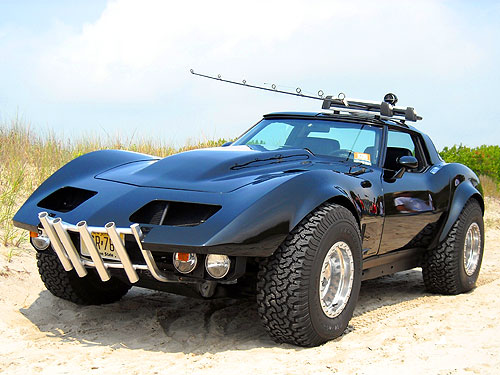
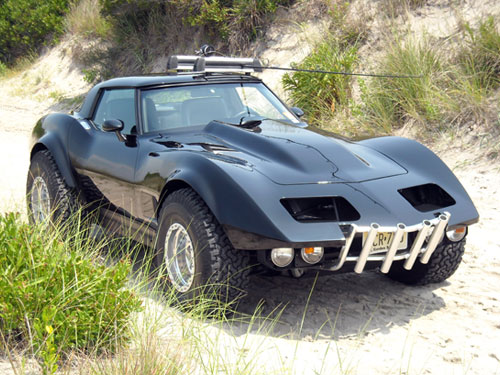
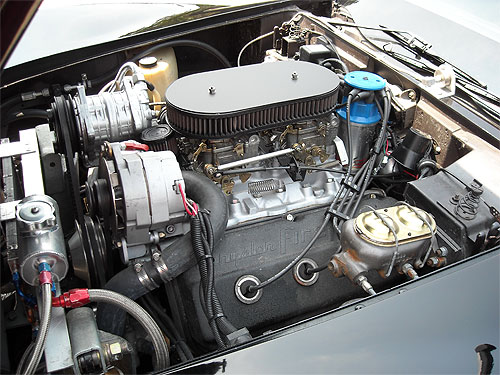
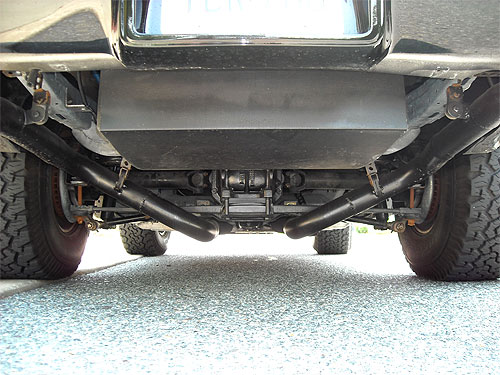

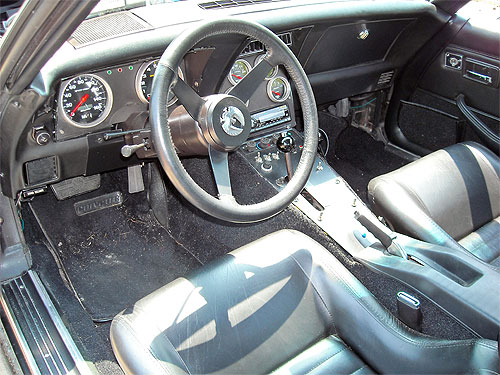
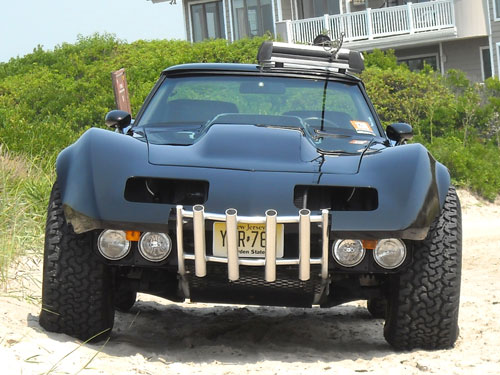
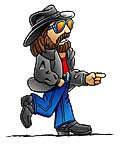
Thank you very much for linking to my Dewey Powell story. yes, that’s 70-plus-year-old Dewey’s daily driver. He’s quite a guy! Thanks. – Scott